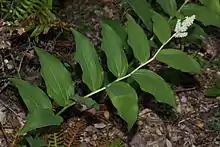Maianthemum racemosum
Maianthemum racemosum (treacleberry, feathery false lily of the valley,[3] false Solomon's seal, Solomon's plume[4][5] or false spikenard; syn. Smilacina racemosa, Vagnera racemosa) is a species of flowering plant native to North America. It is a common, widespread plant known from every US state except Hawaii, and from every Canadian province and territory except Nunavut, as well as from Mexico.[5]
| Maianthemum racemosum | |
|---|---|
 | |
| Scientific classification | |
| Kingdom: | Plantae |
| Clade: | Tracheophytes |
| Clade: | Angiosperms |
| Clade: | Monocots |
| Order: | Asparagales |
| Family: | Asparagaceae |
| Subfamily: | Nolinoideae |
| Genus: | Maianthemum |
| Species: | M. racemosum |
| Binomial name | |
| Maianthemum racemosum | |
| Synonyms[1][2] | |
|
Synonyms list
| |
Description
It is a woodland herbaceous perennial plant growing to 50–90 cm (20–35 in) tall, with alternate, oblong-lanceolate leaves 7–15 cm (2.8–5.9 in) long and 3–6 cm (1.2–2.4 in) broad. The flowers are produced on a 10–15 cm (3.9–5.9 in) panicle, each flower with six white tepals 3–6 mm (0.12–0.24 in) long blooming in late spring. The plants produce green fruits that are round and turn red in late summer.
It spreads by cylindrical rhizomes up to 0.3 m (1 ft 0 in) long.[5]
The Latin specific epithet racemosum means "with flowers that appear in racemes".[6]
Distribution
Maianthemum racemosum grows in habitats in North America up to elevations of 9,000 ft (2,743 m). The most robust and profuse occurrences of this plant are typically found in partial shade and deep, moist, soft soils. In the western part of North America an example typical habitat would be in a shaded ravine or riparian corridor with common understory associates of Dryopteris arguta, Trillium ovatum and Adiantum jordanii.[7]
Cultivation
The plant, like the closely related Polygonatum (Solomon's seal), is suitable for cultivation in moist, humus-rich soil in a woodland setting or in dappled shade.[8] It has gained the Royal Horticultural Society's Award of Garden Merit.[9][10]
Uses and identification
The young shoots, while still tender and stripped of their leaves, can be simmered in water and eaten. Their delicate flavor is somewhat reminiscent of asparagus. However, they should not be collected for this purpose unless they are obviously abundant.
Although the young shoots are edible, the plant becomes too fibrous and bitter to enjoy after it completes flowering and seed setting stages. The Ojibwa Indians harvested the roots of this plant and cooked them in lye water overnight to remove the bitterness and neutralize their strong laxative qualities.
The ripe fruits are edible raw or cooked[11] but may be poor in taste.[12] They can be laxative if consumed in large quantities.
When young, Maianthemum racemosum may closely resemble members of the genus Veratrum, a highly toxic plant to which it is distantly related, or baneberry.[13] Consequently, this plant should not be consumed unless identification is positive.[14]
Native Americans boiled the roots to make tea for medicinal purposes, including to treat rheumatism, kidney issues, and wounds and back injuries.[12]
 M. r. subsp. amplexicaule fruit, Mount Baker-Snoqualmie National Forest
M. r. subsp. amplexicaule fruit, Mount Baker-Snoqualmie National Forest Fruit
Fruit M. r. subsp. amplexicaule, Olympic National Park
M. r. subsp. amplexicaule, Olympic National Park Blooming on roadside
Blooming on roadside
See also
- M. stellatum, also known as false Solomon's seal
- Polygonatum biflorum, Solomon's seal
- Polygonatum commutatum, Solomon's seal
References
- "Maianthemum racemosum". Tropicos. Missouri Botanical Garden.
- "Maianthemum racemosum". World Checklist of Selected Plant Families (WCSP). Royal Botanic Gardens, Kew – via The Plant List.
- "Maianthemum racemosum". Natural Resources Conservation Service PLANTS Database. USDA. Retrieved 28 June 2015.
- "Maianthemum racemosum". Connecticut Plants. Connecticut Botanical Society. 2015.
- LaFrankie, James V. (2002). "Maianthemum racemosum". In Flora of North America Editorial Committee (ed.). Flora of North America North of Mexico (FNA). 26. New York and Oxford – via eFloras.org, Missouri Botanical Garden, St. Louis, MO & Harvard University Herbaria, Cambridge, MA.
- Harrison, Lorraine (2012). RHS Latin for Gardeners. United Kingdom: Mitchell Beazley. ISBN 978-1845337315.
- Hogan, C. Michael (2008). Stromberg, N. (ed.). "Coastal Woodfern (Dryopteris arguta)". GlobalTwitcher.
- RHS A-Z encyclopedia of garden plants. United Kingdom: Dorling Kindersley. 2008. p. 1136. ISBN 978-1405332965.
- "RHS Plant Selector - Maianthemum racemosum". Retrieved 28 December 2020.
- "AGM Plants - Ornamental" (PDF). Royal Horticultural Society. July 2017. p. 63. Retrieved 2 April 2018.
- Facciola. S. Cornucopia - A Source Book of Edible Plants. Kampong Publications 1990 ISBN 0-9628087-0-9
- Fagan, Damian (2019). Wildflowers of Oregon: A Field Guide to Over 400 Wildflowers, Trees, and Shrubs of the Coast, Cascades, and High Desert. Guilford, CT: FalconGuides. p. 24. ISBN 978-1-4930-3633-2. OCLC 1073035766.
- Reiner, Ralph E. (1969). Introducing the Flowering Beauty of Glacier National Park and the Majestic High Rockies. Glacier Park, Inc. p. 114.
- Tilford, Gregory L. (1997). Edible and Medicinal Plants of the West. ISBN 0-87842-359-1.
External links
 Data related to Maianthemum racemosum at Wikispecies
Data related to Maianthemum racemosum at Wikispecies- Blanchan, Neltje (2005). Wild Flowers Worth Knowing. Project Gutenberg Literary Archive Foundation.
| Wikimedia Commons has media related to Maianthemum racemosum. |
